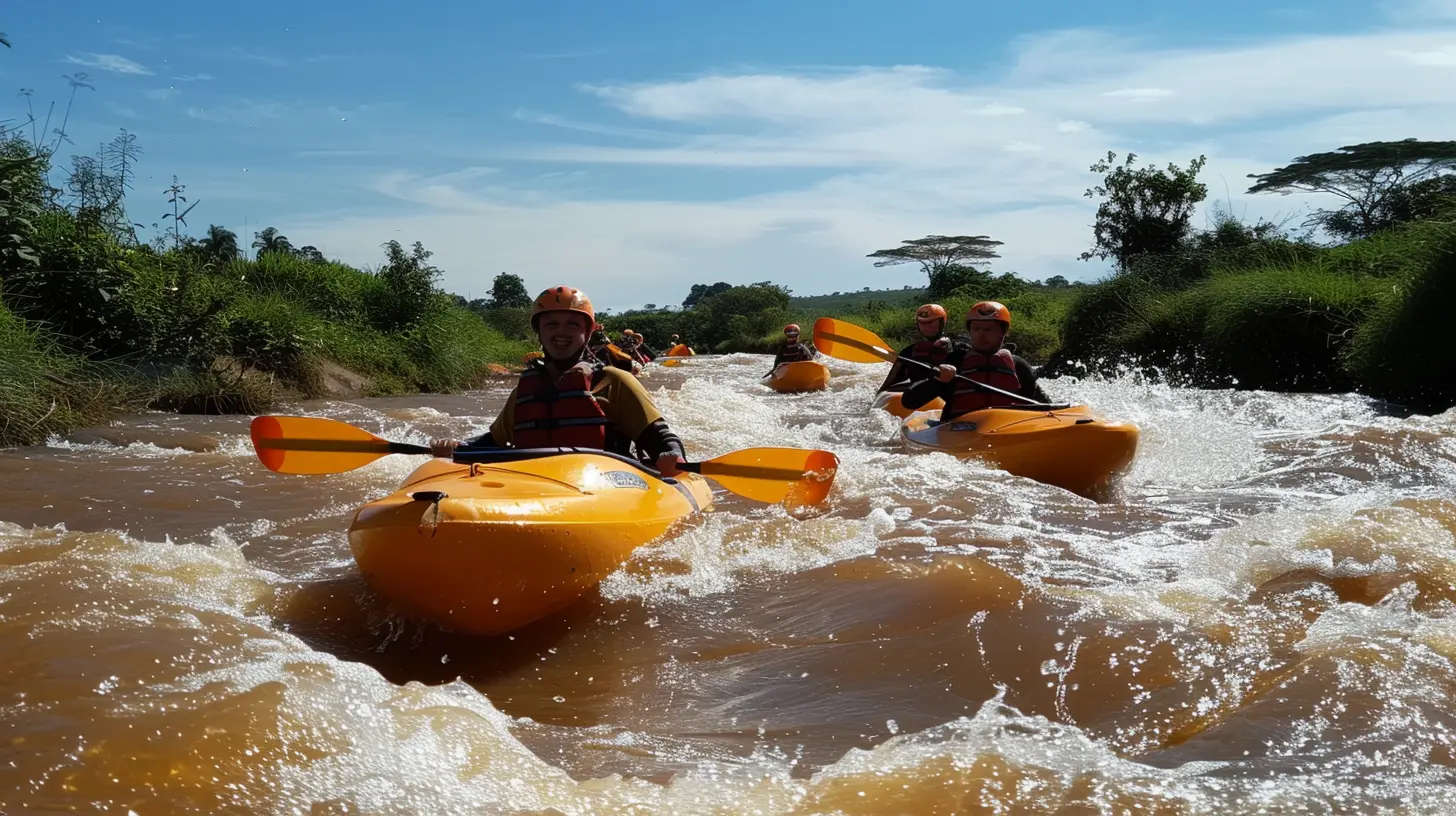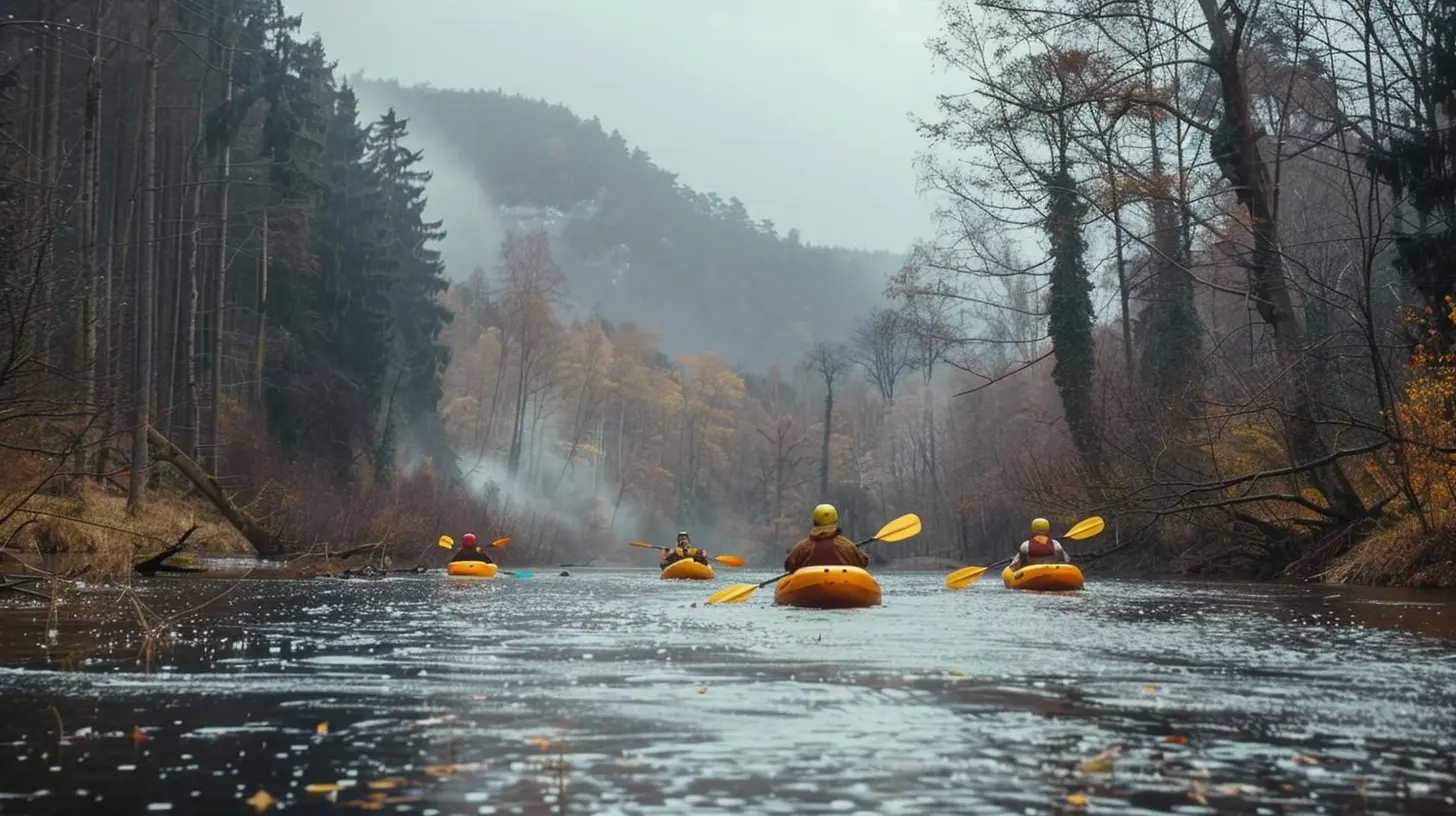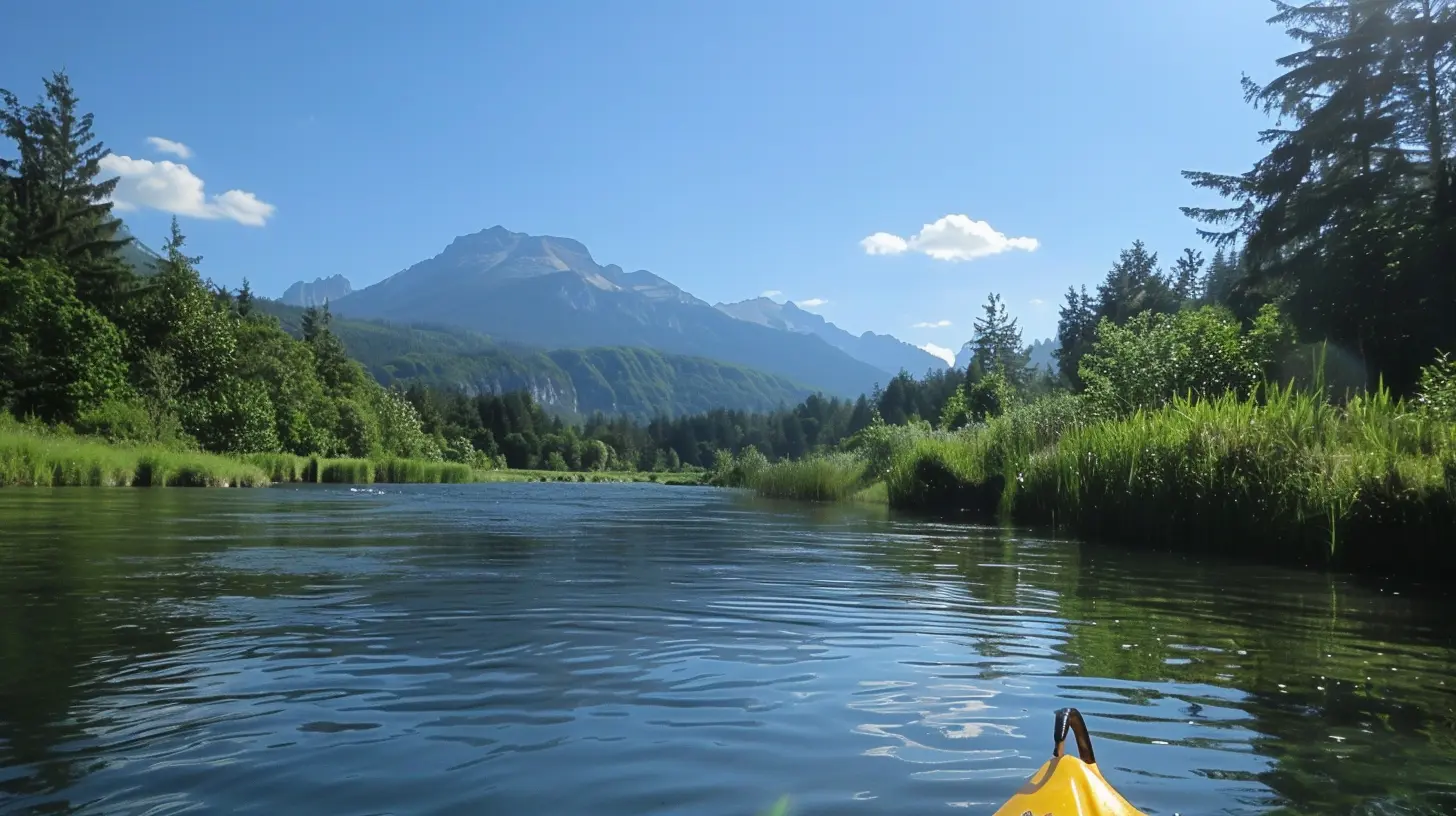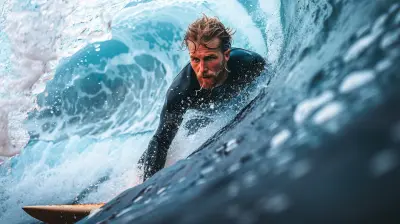Surviving the Rapids: White Water Kayaking for Beginners
28 December 2024
White water kayaking—just hearing the name might make your adrenaline spike. You picture rushing rivers, foaming rapids, and maybe a few crashes into jagged rocks. But here’s the thing: while it does sound intense, white water kayaking is accessible, even for beginners. And before you think you need to be some super-athlete to survive those rapids, let me tell you, with the right mindset and preparation, you can absolutely thrive.
In this guide, we’ll dive into the basics of white water kayaking for beginners. I’ll walk you through what to expect, how to prepare, and—most importantly—how to stay safe while having a blast. So, grab your paddle and let’s get wet!

What is White Water Kayaking?
White water kayaking is a form of kayaking where you navigate a river with varying degrees of turbulence, often caused by obstacles like boulders, drops, and fast-moving water. The term "white water" comes from the frothy, bubbling appearance of the water as it churns through rapids.There are different classifications or grades of rapids, ranging from Class I (easy) to Class VI (extremely dangerous). As a beginner, you’ll want to stick to Class I and II rapids until you gain more experience and confidence.
Why Kayak on White Water?
You might ask, “Why would I want to paddle through rough water when I could just float down a calm river?” Well, white water kayaking offers a unique mix of thrill, skill, and connection with nature. It’s like a rollercoaster ride where you’re in control. One moment, you’re cruising along, enjoying the serenity of the river, and the next, you’re navigating through rushing rapids. It’s unpredictable, exhilarating, and downright fun!Plus, it’s a killer workout. You engage your core, arms, and legs. And let’s not forget your brain—white water kayaking requires quick thinking and laser-sharp focus. You’ll feel alive, present, and totally in the moment. Not to mention, the views are often stunning. Imagine paddling through deep canyons, surrounded by towering cliffs and lush forests. Yeah, it’s as epic as it sounds.

The Gear You’ll Need
Before you get started, you need the right gear. And trust me, having the proper equipment can make all the difference between a fun day on the water and a not-so-fun trip to the ER. So, what’s in the white water kayaking starter kit?1. Kayak
Obviously, you’ll need a kayak. But not just any kayak! White water kayaks are typically shorter, more maneuverable, and have a rounded hull. This design allows you to navigate rapids more easily. If you’re just getting started, consider renting or borrowing a kayak before investing in one.2. Paddle
Your paddle is your primary tool. White water paddles are usually shorter and have a more pronounced blade than those for flatwater kayaking. The blade shape is crucial—it gives you more control and power when you’re navigating fast-moving water.3. Helmet
This isn’t optional. A helmet is a must when kayaking in white water. You never know when you might flip or get tossed into some rocks, so keeping your noggin safe is absolutely essential.4. Personal Flotation Device (PFD)
Think of your PFD as your safety net. Even if you’re a strong swimmer, the currents in white water can be unpredictable and strong. A good PFD will keep you afloat and make it easier to swim if you get ejected from your kayak.5. Spray Skirt
A spray skirt is made of neoprene or rubber and fits snugly around the cockpit of your kayak. It prevents water from splashing into your kayak, keeping you drier, warmer, and more buoyant.6. Appropriate Clothing
You’ll want to wear something that dries quickly and keeps you warm. Synthetic materials like nylon or polyester are great because they don’t hold water like cotton does. In colder water, you might want to consider a wetsuit or drysuit.7. Throw Rope
A throw rope is a safety tool that’s used in rescues. If you or someone in your group gets into trouble, this rope can be thrown to pull them to safety.
Learning the Basics: Techniques and Tips
Okay, so you’ve got your gear. Now what? Let’s talk about some basic techniques and tips to get you started.1. The Wet Exit
Before you even hit the water, one of the first things you’ll need to learn is the “wet exit.” This is how you escape from your kayak if it flips over. It sounds scarier than it is, trust me. Here’s the process:- Stay calm. Yes, you’re underwater, but you’ve got time to get out.
- Lean forward and pull the loop on the front of your spray skirt.
- Push yourself out of the kayak and swim to the surface.
It’s a good idea to practice wet exits in calm water until you feel comfortable with the motion.
2. Basic Paddle Strokes
To control your kayak, you’ll need to master a few key paddle strokes. These are like the ABCs of kayaking:- Forward Stroke: Simple enough, this is how you propel your kayak forward. Keep your paddle close to the kayak and use your core muscles to pull the blade through the water.
- Sweep Stroke: This stroke helps you turn your kayak. Sweep the paddle in a wide arc on one side of the boat to initiate the turn.
- Draw Stroke: Need to move sideways? The draw stroke is your friend. Place the paddle in the water perpendicular to the kayak and pull toward you.
3. Reading the River
One of the most important skills in white water kayaking is learning how to read the river. You’ll need to identify hazards like rocks, eddies, and drops, as well as find the safest path through the rapids (known as the “line”). Start on easier rivers with fewer obstacles and gradually work your way up as your skills improve.4. Bracing
A brace is a technique used to prevent you from flipping over. It’s essentially a quick, powerful stroke on one side of the kayak that helps keep you upright when you start to tip. It’s a move that’s all about timing and practice, but once you master it, you’ll feel way more confident on the water.
Safety First: Navigating the Rapids
White water kayaking is thrilling, but it’s not without its dangers. That’s why it’s crucial to follow some basic safety guidelines to keep yourself and your paddling group safe.1. Never Kayak Alone
Always paddle with a buddy or, better yet, a group. If you get into trouble, having someone else there can be a lifesaver—literally.2. Scout the Rapids
Before entering a rapid, get out of your kayak and walk along the riverbank to scout the section ahead. Look for obstacles, drops, and the clearest line through the rapid. This is especially important as a beginner, as it’ll help you plan your route and avoid trouble.3. Know Your Limits
It’s tempting to jump into more challenging rapids once you’ve got a taste of the thrill, but it’s important to progress at your own pace. Stick to Class I and II rapids until you feel confident in your skills.4. Wear Your Gear
It might sound obvious, but always wear your helmet and PFD. Even if the water looks calm, conditions can change quickly, and having the right gear can save your life.5. Practice Self-Rescue
If you do flip over, knowing how to get back into your kayak is crucial. Practice self-rescue techniques, like the T-rescue or roll, in calm water before trying them out in white water.Building Confidence: Taking Your First Trip
If you’re still feeling a little nervous, that’s totally normal. White water kayaking is challenging, but it’s also incredibly rewarding. The best way to build confidence is by starting small. Take a paddling class or go out with an experienced guide. Many outdoor adventure companies offer introductory trips for beginners where you can learn the ropes in a safe, supportive environment.As you gain more experience, you’ll start to feel more comfortable reading the river, navigating rapids, and—dare I say it—enjoying the chaos of the white water.
Final Thoughts: Embrace the Thrill
White water kayaking is one of those sports that looks intimidating from the outside but is incredibly satisfying once you get the hang of it. Sure, it’ll push you out of your comfort zone, but that’s where the magic happens, right? Every time you paddle through a rapid, you’ll feel a sense of accomplishment that’s hard to match.So, if you’re ready for a challenge, crave adventure, and don’t mind getting a little wet, white water kayaking just might be the perfect extreme sport for you. Paddle hard, stay safe, and embrace the thrill of the rapids!
all images in this post were generated using AI tools
Category:
Extreme SportsAuthor:

Onyx Frye
Discussion
rate this article
17 comments
Claire McLemore
This article effectively demystifies white water kayaking for beginners, highlighting essential safety tips and techniques. By emphasizing gradual skill development and respect for nature's unpredictability, it encourages novice kayakers to embrace adventure while prioritizing safety—a crucial balance in any extreme sport.
February 4, 2025 at 7:49 PM

Onyx Frye
Thank you for your thoughtful feedback! I'm glad the article resonates with you and highlights the importance of safety in white water kayaking for beginners. Happy paddling!
Bianca McAdams
Embrace the splashes and laughs! Every paddle stroke is a step towards mastering those thrilling rapids!
January 30, 2025 at 1:05 PM

Onyx Frye
Absolutely! Every moment on the water is a chance to learn and enjoy the adventure. Happy paddling!
Maggie McEachern
This article beautifully captures the thrill and challenges of whitewater kayaking. As a beginner, I appreciate the practical tips and encouragement—it’s inspiring to see how embracing nature's wild side can lead to personal growth.
January 25, 2025 at 4:45 AM

Onyx Frye
Thank you for your kind words! I'm glad you found the tips helpful and inspiring. Enjoy your kayaking adventure!
Liv Lambert
Great article! The tips for beginners are incredibly helpful for anyone looking to start white water kayaking. I appreciate the emphasis on safety and technique. Excited to hit the rapids!
January 17, 2025 at 12:26 PM

Onyx Frye
Thank you! I'm glad you found the tips helpful. Enjoy your time on the water and stay safe!
Eliza Wyatt
Essential skills and safety tips are crucial!
January 13, 2025 at 7:22 PM

Onyx Frye
Absolutely! Mastering essential skills and safety tips is key to enjoying and navigating white water kayaking safely.
Archer Lawson
Embrace the thrill, respect the water, and enjoy the journey!
January 9, 2025 at 5:09 AM

Onyx Frye
Absolutely! Thrill and respect go hand in hand in kayaking. Enjoy every moment on the water!
Ardyn Kirk
Embrace the thrill of the rapids! White water kayaking is a perfect adventure to build confidence, strength, and unforgettable memories. Dive in!
January 4, 2025 at 9:00 PM

Onyx Frye
Absolutely! White water kayaking is an exhilarating way to boost your confidence and create lasting memories. Dive in and enjoy the adventure!
Zevan Gray
Embrace the thrill of white water kayaking! Every rapid conquered builds confidence and resilience. Dive in, paddle hard, and let the adventure unfold!
January 3, 2025 at 7:58 PM

Onyx Frye
Absolutely! Embracing the thrill is key to building confidence in white water kayaking. Every rapid conquered is a step towards mastering the adventure!
Faenor McDonald
Great article! Your tips for beginners in white water kayaking are practical and encouraging. Can't wait to hit the rapids myself!
January 2, 2025 at 10:06 PM

Onyx Frye
Thank you! I'm glad you found the tips helpful. Enjoy the rapids and stay safe!
Holden Cain
Great tips for beginners! Excited to hit the rapids soon!
January 1, 2025 at 11:20 AM

Onyx Frye
Thanks! Enjoy the adventure and stay safe on the rapids!
George McGuire
Great article! White water kayaking is an exhilarating adventure for beginners. Remember to prioritize safety by wearing the right gear, practicing basic strokes, and understanding river dynamics. Start on Class I or II rapids to build confidence and skills!
January 1, 2025 at 4:30 AM

Onyx Frye
Thank you for your insightful comment! Safety is indeed crucial for a fun and rewarding experience in white water kayaking.
Astralis Matthews
White water kayaking: the only sport where you can paddle with confidence, then instantly redefine ‘going with the flow’ as you navigate the rapids and your own panic!
December 31, 2024 at 1:27 PM

Onyx Frye
Absolutely! White water kayaking truly captures that thrilling balance between confidence and chaos. Embracing the flow—both in the water and within yourself—is key to mastering the rapids!
Melody Erickson
Great tips for beginners! Excited to hit the rapids soon!
December 30, 2024 at 2:01 PM

Onyx Frye
Thanks! Enjoy your adventure on the rapids! Stay safe!
Jace McWilliams
In the dance of roaring waters, courage meets the thrill, Kayaking’s embrace invites the heart to feel, A journey starts, where fears dissolve, And nature’s symphony calls us to explore.
December 30, 2024 at 4:49 AM

Onyx Frye
Thank you for capturing the essence of white water kayaking! Your poetic imagery beautifully reflects the adventure and connection to nature that beginners can experience.
Kenneth Malone
Embrace the thrill of white water kayaking! Every rapid is an opportunity to grow stronger and more confident. Remember, every expert was once a beginner. So grab your paddle, trust the flow, and let the adventure lead you to new heights. You’ve got this—let’s conquer those waves together!
December 29, 2024 at 7:32 PM

Onyx Frye
Absolutely! Embracing the thrill is key to growth in white water kayaking. Let's conquer those waves together and enjoy the journey!
Evelyn O'Neal
Great article! As a beginner in white water kayaking, I found your tips incredibly helpful. The emphasis on safety and gradual progression really resonated with me. I’m excited to apply your advice on technique and gear selection. Thanks for sharing your knowledge—can’t wait to hit the water!
December 28, 2024 at 12:54 PM

Onyx Frye
Thank you so much for your kind words! I'm glad you found the tips helpful and are excited to get out on the water. Safety and progression are key—have fun and paddle safe!
Karen Whitley
Exciting adventures await! Embrace the thrill of whitewater kayaking!
December 28, 2024 at 3:43 AM

Onyx Frye
Absolutely! Embracing the thrill of whitewater kayaking not only promises adventure but also a chance to connect with nature. Let's dive in!
MORE POSTS

Breaking Down the Science of Synthetic Hormones in Sports

How to Develop a Winning Football Mindset

Mastering the Art of Carving: Skiing Techniques for Every Slope

Punching Power vs. Precision: Which Matters More?

Skiing with Kids: Making it Fun and Safe for the Whole Family

The Draft’s Biggest Boom-or-Bust Candidates

The Best CrossFit Workouts for Building Endurance

How Pre-Draft Workouts Can Make or Break a Prospects Stock

The Rise of Esports and What It Means for Traditional Sports Marketing

Surfing in Cold Water: Tips for Staying Warm and Safe

Surviving the Sahara: Endurance Racing in the Hottest Desert on Earth